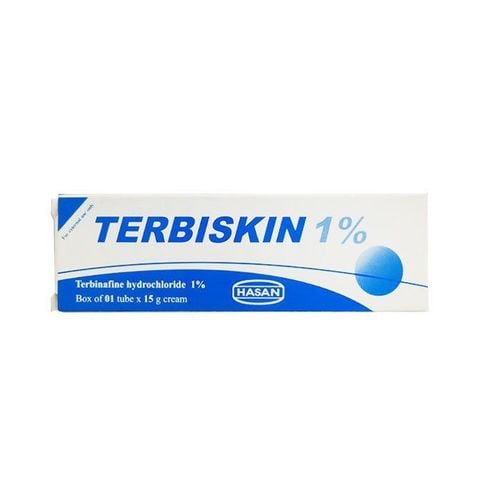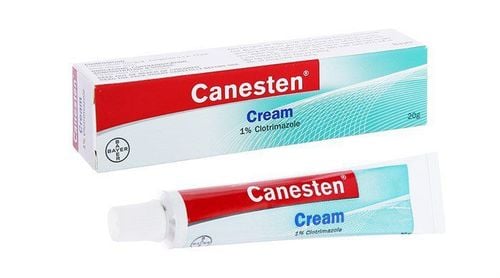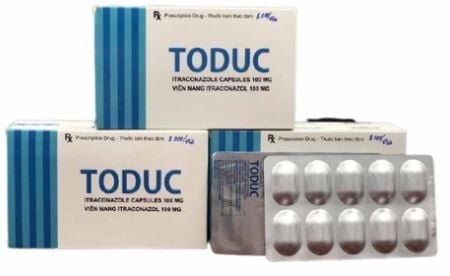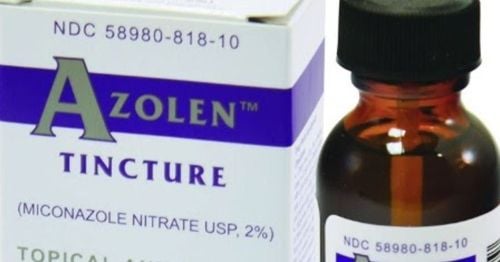This is an automatically translated article.
Itaspor belongs to the group of antiparasitic, anti-infective, antiviral, and antifungal drugs used to treat fungal infections. Below is detailed information on what Itaspor is and what precautions should be taken when using it.1. What is Itaspor?
Itaspor drug is made in the form of capsules, with the main ingredient is Itraconazole with the content of 100mg. Itraconazole is a triazole derivative, belongs to the group of oral antifungal drugs, has a broad spectrum of antifungal activity, inhibits the growth of many pathogenic fungi such as yeasts (Candida strains including C. albicans, C. krusei, C. glabrata), dermatophytes (strains of Trichophyton spp., Epidermophyton floccosum, Microsporum spp.,), Aspergillus spp., Cryptococcus neoformans, Pityrosporum spp., strains of Trichosporon spp., Geotrichum spp., Histoplasma spp., Parailicocci Sporothrix schenckii, Cladosporium spp., Blastomyces dermatitidis, Fonsecaea spp., Penicillium marneffei, Pseudallescheria boydii and other fungi. Candida strains less sensitive to Itraconazole are C. glabrata and C. tropicalis. Fusarium spp., Zygomycetes (Rhizomucor spp., Rhizopus spp., Absidia spp., Mucor spp.), Scedosporium spp. and Scopulariopsis spp. are fungi that are not inhibited by Itraconazole. Itraconazole interferes with the synthesis of ergosterol - an important component of fungal cell membranes, thereby having antifungal effects. Itraconazole is rapidly absorbed after oral administration, peak concentrations are reached 2 - 5 hours after oral administration, is extensively metabolised in the liver and excreted in the feces and urine.
2. What effect does Itaspor drug have?
Itaspor is used in the following cases:
Fungal infections of the skin such as fungus between the fingers, feet, nails, toenails, inguinal fungus. Lang Ben . Candidiasis of the mouth - throat, vulva - vagina. Visceral fungal infections: Candida, Aspergillus, Cryptococcus, Histoplasma, Paracoccidioides, Sporothrix, Blastomyces. Maintenance therapy to prevent recurrent latent fungal infections in people with HIV/AIDS. Prophylaxis of fungal infections in case of prolonged neutropenia.
3. Contraindications of the drug Itaspor
Do not use Itaspor in the following cases:
People who are sensitive to Itraconazole or other azole antifungals. Do not use with terfenadine, astemizol, cisapride, midazolam and oral triazolam.
4. Dosage and how to use Itaspor
The dose of the drug depends on the condition of the disease and should be taken immediately after eating.
Vaginal - vaginal candidiasis: Take 4 tablets divided into 2 times/day for 1 day; or 2 tablets / time / day x 3 days. Ringworm: Take 2 tablets/time/day x 7 days. Ringworm: Take 2 tablets / time / day x 7 days or 1 tablet / day x 15 days. The fungus on the soles of the feet, the palms of the hands can be highly keratinized: Take 4 tablets divided into 2 times / day x 7 days or 1 tablet / day x 30 days. Oral candidiasis: 1 capsule/day x 15 days. People with AIDS, neutropenia or organ transplant: Take 2 tablets/time/day x 15 days. Toenail fungus: Take 2 tablets x 2 times/day x 7 days, treat 2-3 times, 3 weeks apart, or treat continuously 2 tablets/time/day x 3 months. Visceral fungal infections: Aspergillus: Take 2 tablets/time/day x 2-5 months, if the disease does not progress, the dose can be increased to 2 tablets x 2 times/day. Candida: Take 1-2 tablets/time/day x 3 weeks to 7 months. Epidural Cryptococcus: Take 2 tablets/time/day x 2 months to 1 year. Cryptococcal meningitis: Take 4 tablets 2 times a day. Then take 2 tablets / time / day for maintenance treatment. Histoplasma infection: Take 2 tablets x 1-2 times/day x 8 months. Fungal infection Sporothrix schenckii: Take 1 tablet / day x 3 months. Paracoccidioides brasiliensis: Take 1 tablet/day x 6 months. Chromomycosis (Fonsecaea, Cladosporium): 1-2 tablets/time/day x 6 months. Blastomyces dermatitidis: 1 tablet/day or 2 tablets x 2 times/day x 6 months.
5. Side effects of the drug Itaspor
When using the drug Itaspor may experience some unwanted effects as follows:
Headache. Nausea, abdominal pain, indigestion. Uncommon pruritus, allergic reactions, rash, urticaria, angioedema, Stevens-Johnson syndrome, reversible elevation of liver enzymes, menstrual disorders Rarely, hypokalemia. When using Itaspor medicine, if the patient experiences any serious side effects, stop taking the drug and immediately contact the treating doctor or go to the nearest medical facility for timely treatment.
6. Interaction with Itaspor
When combined with Itaspor may interact with the following drugs:
Do not use concomitantly with terfenadine, cisapride, astemizol because it increases blood levels of these drugs, prolongs the QT interval and may lead to torsion top. Itraconazole should not be used together with oral midazolam and triazolam.
7. Notes and cautions when using Itaspor
When using Itaspor drug, caution should be taken in the following cases:
The drug is metabolized mainly in the liver, the half-life of the drug is prolonged when used for people with liver damage. Therefore, caution should be exercised when using the drug for people with a history of liver disease, monitoring liver function when using it for a long time. Pregnant or lactating women: Use the drug only when the visceral fungal infection is severe, life-threatening and when carefully weighing the benefits of treatment and the risk of harm to the fetus. In addition to the above information, if you have any questions about Itaspor, you can contact your doctor for advice and answers.













